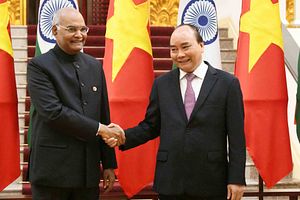Last week, India’s president paid a state visit to Vietnam. Although the trip was just one of a series of scheduled engagements by the two sides for 2018, it once again put the spotlight on growing comprehensive strategic partnership between the two Asian states amid wider domestic and regional developments underway.
While the official relationship between India and Vietnam began in 1972, aspects of ties date back decades prior, and certain events, including Jawarhalal Nehru’s first visit to Vietnam, continue to receive attention even in contemporary relations. The two countries have also been looking to further upgrade relations in a more institutionalized and wide-ranging way over the past few years, with a key inflection point being the upgrading to the level of a comprehensive strategic partnership back in 2016 and advances made in certain areas, including the maritime realm (See: “India-Vietnam Coast Guard Cooperation in the Spotlight“).
Last week, the relationship was in the headlines again with the visit of Indian President Ram Nath Kovind to Vietnam. Kovind was on a state visit to Vietnam from November 18 to 20, where he met with a range of officials including the General Secretary of the Communist Party of Vietnam and President Nguyen Phu Trong.
The official focus of the visit was on discussing a joint vision to further deepen the Vietnam-India comprehensive strategic partnership. The two sides discussed a wide variety of issues as part of that, across the security, economic, and people-to-people realms of ties. Topics included reaching the goal of $15 billion in two-way trade, increasing direct flights between the two countries, intensifying oil and gas cooperation, and progress on the implementation of a $100 million credit package to support Vietnam’s border forces in building high-speed patrol boats.
Unsurprisingly, broader regional and international issues factored into their discussion as well. They referenced efforts to manage challenges caused by trade protectionism, and the two sides also discussed the South China Sea issue, which made an appearance in official accounts of the interactions as well. The two sides also framed their collaboration within the broader prism of promoting openness, peace, prosperity, and collaboration in the Indian and Pacific Oceans – a continued sign of references made within the bilateral relationship to the wider conversation on the Indo-Pacific.
As I have observed previously with respect to such interactions, inroads both sides are continuing to make should not obscure the broader realities and structural constraints that exist, including India being just one partner for Vietnam within its wider omni-directional foreign policy, the limits of strategic alignment between New Delhi and Hanoi across specific issues, and the remaining obstacles to development in particular areas of defense cooperation on both sides despite the sunny rhetoric. Nonetheless, engagements at various levels, including this dialogue at the deputy ministerial level, continue to provide opportunities for both sides to manage this aspect of ties.
To be sure, the public aspects of the visit focused on the positive impact of ties and less on the challenges both sides face, be it in terms of implementing existing cooperation or pursuing further endeavors for a range of reasons including their own domestic politics. And Kovind’s visit was just one of several interactions within the relationship – as an example, on the defense side, General Bipin Rawat, the chief of army staff of the Indian Army, was also in Hanoi, which provided both sides the opportunity to discuss the defense relationship. Nonetheless, the wider relationship will continue to be a notable one to watch in the coming years amid both developments in bilateral ties as well as broader regional and international developments.

































